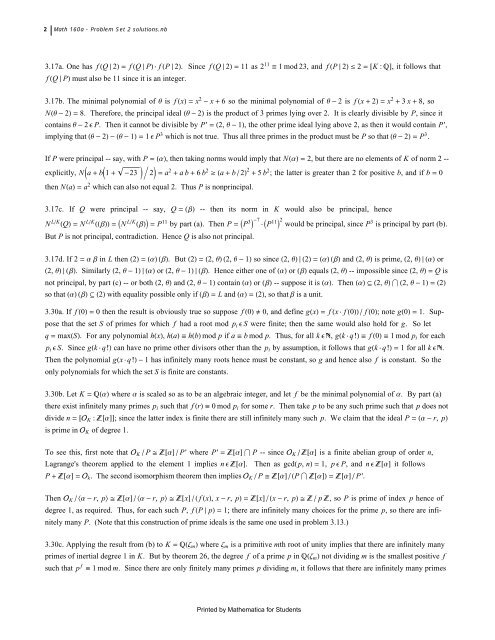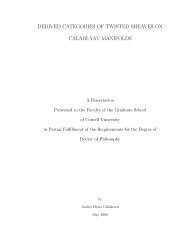Math 160a - Problem Set 2 Evan Dummit
Math 160a - Problem Set 2 Evan Dummit
Math 160a - Problem Set 2 Evan Dummit
You also want an ePaper? Increase the reach of your titles
YUMPU automatically turns print PDFs into web optimized ePapers that Google loves.
2 <strong>Math</strong> <strong>160a</strong> - <strong>Problem</strong> <strong>Set</strong> 2 solutions.nb<br />
3.17a. One has f HQ » 2L = f HQ » PL ÿ f HP » 2L. Since f HQ » 2L = 11 as 2 11 ª 1 mod 23, and f HP » 2L § 2 = @K : �D, it follows that<br />
f HQ » PL must also be 11 since it is an integer.<br />
3.17b. The minimal polynomial of q is f HxL = x 2 - x + 6 so the minimal polynomial of q -2 is f Hx + 2L = x 2 + 3 x + 8, so<br />
NHq -2L = 8. Therefore, the principal ideal Hq -2L is the product of 3 primes lying over 2. It is clearly divisible by P, since it<br />
contains q-2 e P. Then it cannot be divisible by P' = H2, q-1L, the other prime ideal lying above 2, as then it would contain P',<br />
implying that Hq - 2L - Hq - 1L = 1 e P3 which is not true. Thus all three primes in the product must be P so that Hq - 2L = P3 .<br />
If P were principal -- say, with P = HaL, then taking norms would imply that NHaL = 2, but there are no elements of K of norm 2 -explicitly,<br />
NJa + bJ1 + -23 Ní2N = a2 + ab+ 6 b2 ¥ Ha + b ê 2L 2 + 5 b2 ; the latter is greater than 2 for positive b, and if b = 0<br />
then NHaL = a 2 which can also not equal 2. Thus P is nonprincipal.<br />
3.17c. If Q were principal -- say, Q = HbL -- then its norm in K would also be principal, hence<br />
N LêKHQL = N LêKHH bLL = IN LêKHbLM = P11 by part (a). Then P = IP3M -7 ÿ IP11M 2 would be principal, since P3 is principal by part (b).<br />
But P is not principal, contradiction. Hence Q is also not principal.<br />
3.17d. If 2 =ab in L then H2L = HaLHbL. But H2L = H2, qL H2, q - 1L so since H2, qL»H2L = HaL HbL and H2, qL is prime, H2, qL»HaL or<br />
H2, qL»HbL. Similarly H2, q-1L»HaL or H2, q-1L»HbL. Hence either one of HaL or HbL equals H2, qL -- impossible since H2, qL = Q is<br />
not principal, by part (c) -- or both H2, qL and H2, q-1L contain HaL or HbL -- suppose it is HaL. Then HaL Œ H2, qL›H2, q-1L = H2L<br />
so that HaLHbL ΠH2L with equality possible only if HbL = L and HaL = H2L, so that b is a unit.<br />
3.30a. If f H0L = 0 then the result is obviously true so suppose f H0L ∫ 0, and define gHxL = f Hx ÿ f H0LL ê f H0L; note gH0L = 1. Suppose<br />
that the set S of primes for which f had a root mod pi e S were finite; then the same would also hold for g. So let<br />
q = maxHSL. For any polynomial hHxL, hHaL ª hHbL mod p if a ª b mod p. Thus, for all k e �, gHk ÿ q!L ª f H0L ª 1 mod pi for each<br />
pi e S. Since gHk ÿ q!L can have no prime other divisors other than the pi by assumption, it follows that gHk ÿ q!L = 1 for all k e �.<br />
Then the polynomial gHx ÿ q !L - 1 has infinitely many roots hence must be constant, so g and hence also f is constant. So the<br />
only polynomials for which the set S is finite are constants.<br />
3.30b. Let K = �HaL where a is scaled so as to be an algebraic integer, and let f be the minimal polynomial of a. By part (a)<br />
there exist infinitely many primes pi such that f HrL ª 0 mod pi for some r. Then take p to be any such prime such that p does not<br />
divide n = @�K : �@aDD; since the latter index is finite there are still infinitely many such p. We claim that the ideal P = Ha -r, pL<br />
is prime in �K of degree 1.<br />
To see this, first note that �K ê P @ �@aD ê P' where P' = �@aD›P -- since �K ê �@aD is a finite abelian group of order n,<br />
Lagrange's theorem applied to the element 1 implies n e �@aD. Then as gcdHp, nL = 1, p e P, and n e �@aD it follows<br />
P + �@aD = �k. The second isomorphism theorem then implies �K ê P @ �@aD ê HP › �@aDL = �@aD ê P'.<br />
Then �K ê Xa -r, p\ @ �@aD ê Xa -r, p\ @ �@xD ê H f HxL, x - r, pL = �@xD ê Hx - r, pL @ � ê p �, so P is prime of index p hence of<br />
degree 1, as required. Thus, for each such P, f HP » pL = 1; there are infinitely many choices for the prime p, so there are infinitely<br />
many P. (Note that this construction of prime ideals is the same one used in problem 3.13.)<br />
3.30c. Applying the result from (b) to K = �HzmL where zm is a primitive mth root of unity implies that there are infinitely many<br />
primes of inertial degree 1 in K. But by theorem 26, the degree f of a prime p in �HzmL not dividing m is the smallest positive f<br />
such that p f ª 1 mod m. Since there are only finitely many primes p dividing m, it follows that there are infinitely many primes<br />
Printed by <strong>Math</strong>ematica for Students

















